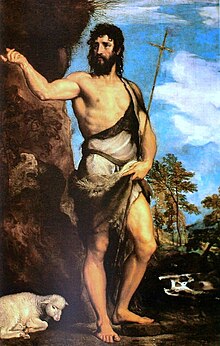Last prophet
The last prophet, or final prophet, is a term used in religious contexts to refer to the last person through whom God speaks, after which there is to be no other. The appellation also refers to the prophet who will induce mankind to turn back to God.
Abrahamic religions
Judaism
Judaism considers Malachi to be the last of the biblical prophets,[1] but believes that the Messiah will be a prophet and that there will possibly be other prophets alongside him.[citation needed]
Christianity

In Christianity, the last prophet of the Old Covenant before the arrival of Jesus is John the Baptist (cf. Luke 16:16).[2] The Eastern Orthodox Church holds that Malachi was the "Seal of Prophets" in the Old Testament.[3] Christian denominations who hold that spiritual gifts (including prophecy) continue to be bestowed by the Holy Spirit on Christians are known as "continuationists" (including Catholics, Methodists, and Pentecostals), while the cessationist perspective, which teaches that charismata ended in the Apostolic era, is held by much of Reformed Christianity and Baptists.[4][5]
The Iglesia ni Cristo, an independent, nontrinitarian Christian religion based in the Philippines, professes that founder and first Executive Minister Felix Manalo was the last messenger sent by God to reestablish the original church founded by Jesus.[6]
Gnosticism
In Mandaeism, John the Baptist is the greatest and final prophet.[7][8]
Mani, founder of the Persian faith Manichaeism, also claimed to be the Seal of the Prophets and the last prophet.[9]
Islam
Part of a series on Islam Islamic prophets |
|---|
|
|
The phrase Khatamu ’n-Nabiyyīn ("Seal of the Prophets") is a title used in the Quran to designate the Islamic prophet Muhammad. It is generally regarded to mean that Muhammad is the last of the prophets sent by God.
Dharmic religions
Hinduism
In Hinduism, the history of mankind is described in four religious (dharmic) ages (yugas), which depict a gradual decline in religious activities, only to be renewed at the end to start a new cycle of the four ages. At the end of Kali Yuga, the current and last age in a cycle, Kalki, the 10th avatar of Bhagwan Vishnu, is prophesied to appear to punish the wicked, reward the good, and inaugurate Satya Yuga of the next cycle. Kalki is the last avatar in the current cycle.[10]
References
- ^ Anne de Graaf; José Pérez Montero (2015). Reform - The Last Prophets. Trajectory, Incorporated. p. 30. ISBN 9788771327663.
- ^ a b John F. MacArthur (1 March 2006). John 1-11 MacArthur New Testament Commentary. Moody Publishers. p. 124. ISBN 978-0-8024-8044-6.
John the Baptist was the last prophet under the old covenant (Luke 16:16); Jesus came as the mediator of the new covenant (Heb. 8:6; 12:24), which He ratified by His sacrificial death (Luke 22:20; 1 Cor. 11:25).
- ^ "Marina Finogenova. Malachi, the "Seal of the Prophets"". OrthoChristian.Com.
- ^ Bellini, Peter (4 September 2015). "Pentecostals Don't Have a Copyright on the Holy Spirit (Part I)". Retrieved 20 August 2021.
- ^ Dawson, Steve; Hornbacher, Mark (10 April 2019). Ordinary Christians, Extraordinary Signs: Healing in Evangelization. The Word Among Us Press. ISBN 978-1-59325-007-2.
The Catholic Church is "continuationist," rather than "cessationist." What does that mean? Cessationism is the belief that the signs and wonders of the New Testament Church—the extraordinary spiritual gifts (charisms) like tongues, prophecy, or healing—were only intended for a time and ceased to be present in the Church after that period of time had elapsed. Continuationism, on the other hand, is the belief that the signs and wonders of the early Church have continued.
- ^ J. Gordon Melton; Martin Baumann (2010). Religions of the World: A Comprehensive Encyclopedia of Beliefs and Practices, 2nd Edition [6 Volumes]. ABC-CLIO. p. 1387. ISBN 9781598842043.
- ^ Buckley, Jorunn Jacobsen (2002), The Mandaeans: ancient texts and modern people (PDF), Oxford University Press, ISBN 9780195153859
- ^ Drower, Ethel Stefana. The Mandaeans of Iraq and Iran. Oxford At The Clarendon Press, 1937.
- ^ Ort, L. J. R. (1967). Mani: A Religio-historical Description of His Personality. Brill Archive. p. 124.
- ^ Brockington, J. L. (1998). Sanskrit Epics. ISBN 9004102604. Retrieved 2020-07-30.
